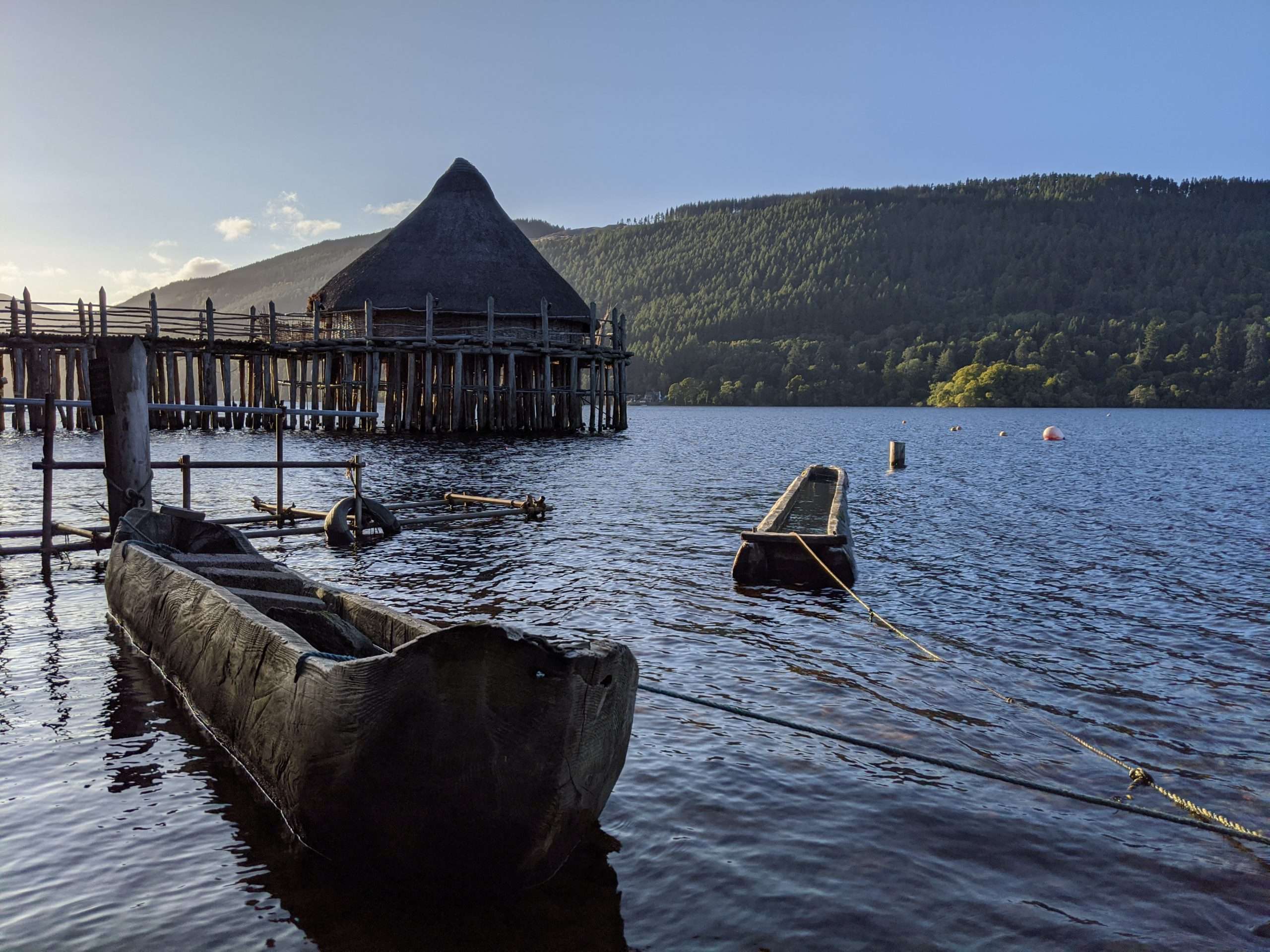By: David C. Weinczok
Previously, I shared five of my favourite Scottish medieval castles and five of my favourite ancient sites. Now, it’s time to pick five from the somewhat awkward middle child, the Early Historic period. You may be more familiar with the term ‘Dark Ages’, though that’s now parlance of the past as more and more is being illuminated by archaeologists and historians.
The parameters of this period are somewhat subjective, with no firm start or end date to anchor it to. In broad strokes, I think of it as encompassing the Roman invasions of Scotland in the first century AD through to the height of the Viking Age in the tenth century. In that time, some things changed drastically when compared with earlier periods, while many of the fundamental rhythms of daily life remained very similar to those in the Iron Age. It may be one of the more ‘obscure’ and less well-understood periods of our history, but it gave Scotland its essential shape – both literally and figuratively – and there are plenty of remnants of it to explore.
Rough Castle, Falkirk
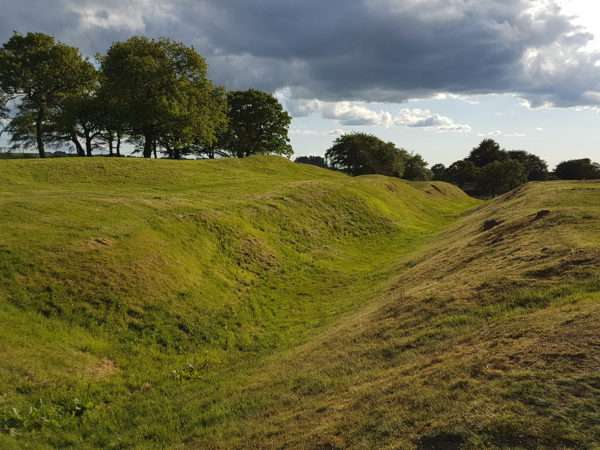
Don’t let the name deceive you – Rough ‘Castle’ is more than twice as old as any actual castle in Scotland. It is the name of the Roman fort constructed along the Antonine Wall to the west of what is now Falkirk. The Antonine Wall ran for 40 miles from Carriden in the east to Old Kilpatrick in the west, cutting Scotland horizontally in two along the Forth-Clyde line. Its defences were made of earth and timber upon a stone foundation, hence why it has not survived as well as sections of Hadrian’s Wall.
The lands between the two Roman walls was populated by Brittonic tribes who responded to the arrival of Rome with varying degrees of hostility and diplomacy. While the legions marched and built forts much further north than this – possibly as far as the Moray Firth – it is thrilling to stand on the steep-sloped embankments of Rough Castle knowing that this is where, as far as Rome was concerned, civilisation ended and the unfathomable wilds began. The scale of the wall’s ditch at Rough Castle is vivid thanks to the open ground around it. In one section, a staggered set of oval-shaped pits are still perfectly visible.
These lilia were fitted with wooden spikes to slow down any attack on the wall itself. Rough Castle also boasted stone buildings including a bath house, granary, and officer’s quarters. All that effort was for nought, however – the Antonine Wall was occupied for a mere 20 years, between 140 – 160 AD, before it was abandoned for a surer, more southerly frontier.
Midhowe Broch, Rousay
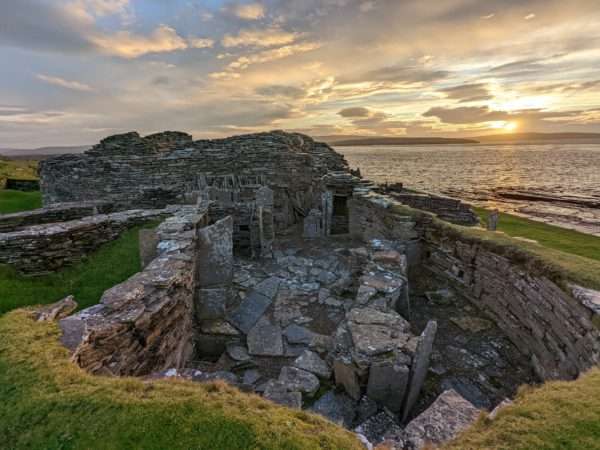
As with my choices for my favourite prehistoric sites, Orkney could have monopolised this list. Even choosing just one Orcadian broch is a challenge – the Broch of Gurness is the best-known and obvious pick, or maybe the Broch of Borwick spectacularly sited on the high cliffs of Yesnaby. Yet there’s just something about Midhowe Broch, along the Wesness shore in Rousay, that can’t be beat. Perhaps it’s the sheer gauntlet of history around it that adds to the appeal. Within a ten-minute walk of Midhowe is a Viking-age cemetery, a medieval church, the multi-period site of Swandro, and the gigantic, Neolithic chambered cairn which shares the name of Midhowe, as well as natural stone arches and breathtaking views across the Eynhallow Sound. Or maybe it’s the broch’s construction itself.
One of at least eleven brochs which once lined the shores of the Sound, Midhowe Broch is built between two geos, narrow clefts in the coastal rocks. Razor-like upright stones line its exterior, and a sea wall built with a distinctive technique called cassying makes the whole site appear incredibly powerful in the face of the lashing sea. A community thrived here for several centuries on either side of the BC/AD divide. Though the exact nature of their lives will likely never be known, whenever I visit Midhowe I always take time to sit at the edge of the central hearth, stare through the tall, narrow passageway framing the sea, and feel a moment of unity with them.
The Scottish Crannog Centre, Loch Tay
Crannogs, or at least crannog sites, are instantly recognisable on countless lochs and brackish shores around Scotland. If you see a small, circular islet in a loch, usually with a few trees growing on it, and no other islands immediately around it, there’s a good chance it once hosted a crannog. The Scottish Crannog Centre is on the northeast shore of Loch Tay, which had one of the densest concentrations of crannogs known anywhere. The debate continues to rage about what crannogs were meant for. They emerge in the Early Bronze Age, and some were inhabited well into the Middle Ages. The timber stilts on which their foundations rested imply a measure of defence, yet crannogs were not otherwise fortified.
Theories range from population pressures on the land to crannogs functioning as community strengthening exercises, given that it took hundreds of huge timbers and tens of thousands of hours of labour to build one. The result is a little like the overwater bungalows you see in glossy travel ads set in Polynesia – not the first thing you expect to see on a Highland loch! The Scottish Crannog Centre has a museum dedicated to the material culture of crannogs, as well as a miniature crafts village where visitors can work a lathe, taste a 2,000 year-old recipe for garlic bread, and experience many other hands-on approaches to learning history.
Tragically, the replica crannog itself was destroyed in an accidental fire in June 2021. However, with renewed purpose the Crannog Centre has already begun constructing not one, but three replica crannogs on the opposite side of the loch. Once complete, Loch Tay will have a veritable Early Historic makeover.
Dunino Den, East Fife
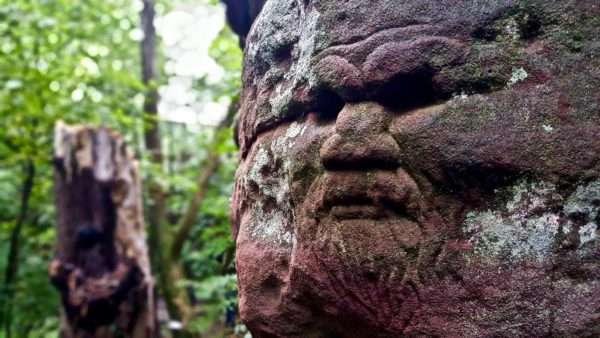
Some places have a certain air about them – a pinch of mystery, a bit of playfulness, a hint of foreboding. Few places exude it quite as potently as Dunino Den, a few miles south of St Andrews. A ritual centre for well over 2,000 years, it can be dead still on a gusty day and brooding dark on a sunny one. And, just when you think you’ve settled in, you see the stone face watching you. Tucked in a gully alongside Dunino Parish Church, Dunino Den is now used as a clootie well where people tie strips of cloth to tree branches and leave personal mementos, often in memory to those who departed this world too soon, in its soils.
During the height of the COVID-19 pandemic, I even found a face mask strung to a small stump – truly, a symbolic merger of modernity and antiquity if ever there was one. Atop a pulpit-like stone projection which overlooks the gully is a deep, water-logged hole, the bottom of which I’ve never been able to reach even with a very long branch. A narrow stone stair carved into the pulpit descends into the Den itself, with numerous Early Christian crosses carved into the smooth stone wall beside you. More often than not, Christianity did not so much erase the old pagan gods as they co-opted them – a healing well previously dedicated to a pagan deity would just be swapped for a similar saint, for instance.
The most striking carving in the den is a small but incredibly stern and ominous face, its heavy-set eyes and long beard guarding the Den like an elemental sentinel. Fans of Game of Thrones will instantly relate it to the faces carved in the sacred Weirwood trees in northern strongholds like Winterfell. And yet, this is no ancient visage but a strikingly modern one. Locals insist that the carving only appeared in the last thirty or forty years, which goes to show that not all at Dunino Den is what it first seems.
Dumbarton Rock, West Dunbartonshire
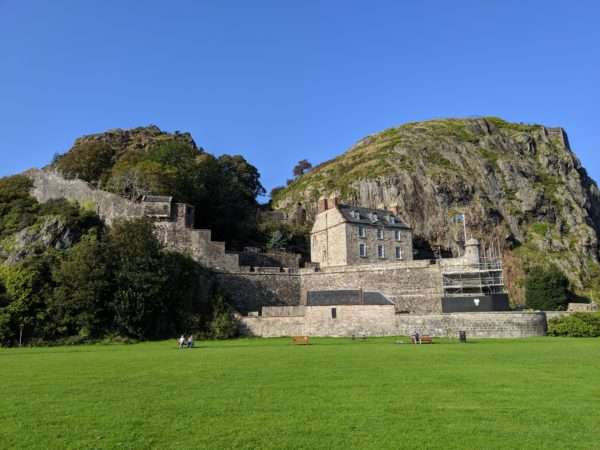
Along the otherwise placid banks of the River Clyde, the twin crags of Dumbarton Rock stick out of the landscape like a double-exclamation. Quite possibly the oldest continually fortified site anywhere in Britain, this was once the capital of the Strathclyde Britons, the children of the Rock. A history of Dumbarton Rock reads like an abridged history of Scotland. Its inhabitants watched with trepidation as the Romans built the westernmost outpost of the Antonine Wall just a few miles upstream. In the last few decades of the fourth century, they would have participated in overrunning that grand symbol of empire in what Roman historians called the ‘Barbarian Conspiracy’.
In 870 a vast Viking fleet led by Ivar the Boneless besieged Dumbarton Rock – then called Dùn Breatann – for months until its water supplies ran dry. The Britons were enslaved and sold in Dublin markets, though some fled and made their way to their kindred in Wales. Another indignity seized Dumbarton when its governor, Sir John de Menteith, captured William Wallace and held him within the castle before sending him to London to be tried and executed. It was also from Dumbarton that a six year-old Mary, Queen of Scots, set sail for France to marry the dauphin. Much nearer our own time, gun emplacements were set atop the rock to shoot down Nazi bombers aiming for the industrial and shipbuilding heartland of the Clyde.
All of this makes a deep well of imagination and contemplation to draw from while resting at its top. My favourite place to sit is on the smoothened stones on The Beak, the taller of the two crags. I imagine Ivar the Boneless triumphantly placing one foot upon the highest stone; Wallace shouting traitor! to his captor; a young Mary determined not to cry as her feet left Scottish soil. And here you can be, in the footsteps of them all. How lucky we are to have such places to instil wonder in the past, and inspire us into the future.
Main photo: The Scottish Crannog Centre.

